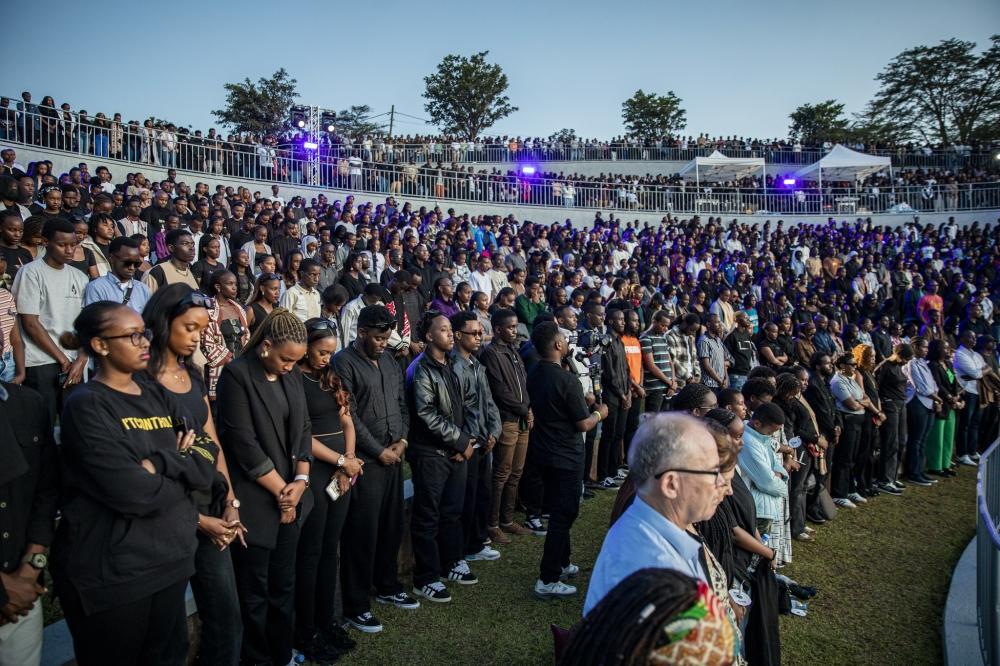Tom Ndahiro
Africa-Press – Rwanda. More than 31 years have passed since 1994. The years have moved forward, but for those who carry the memories, time has never truly healed. The pain does not diminish; it only changes form. The wounds may no longer bleed, but they remain open, raw, and exposed—especially when the world refuses to see them.
How does one describe the pain of being born into a world that rejects you? How does one explain the torment of growing up in a land that calls you a foreigner, even though your ancestors lived there for centuries and millenia? How does one endure the certainty that at any moment, for no crime other than existing, you could be beaten, tortured, exiled, or murdered?
For the Tutsi of Rwanda, suffering was not sudden; it was systematic. It was woven into the fabric of everyday life. The state had sanctioned their persecution, and society had been conditioned to treat them as subhuman. They were blamed for everything, despised for nothing, and punished for merely being.
Someone understood this very well, when he said: “Being a Tutsi requires tremendous courage.”
Tom Ndahiro.
This was the title of an article published in Kiberinka, Issue No. 7, on March 23, 1992, slightly over two years before April 7, 1994. Its author and Editor in chief of this publication—Vincent Shabakaka, was not exaggerating. By the time he wrote these words, genocide was already unfolding in Bugesera, an area South of Rwanda’s Capital Kigali.
But he was not just writing about Bugesera. He was writing about Rwanda—a Rwanda where, for decades, to be Tutsi meant to live under relentless persecution, humiliation, and suffering. He listed the ways a Tutsi could suffer in Rwanda before 1994, and here I will mention a few out of a long list:
To be beaten with thorns until your skin was raw.
To be forced to drink porridge from a shoe.
To have your testicles pierced with pins.
To have a rock tied around your neck and be thrown into a river.
To be beaten with clubs until your bones broke.
To watch your child slaughtered and thrown into a pit latrine.
To see your home burned down and not be allowed to put out the fire.
To suffer hunger, even though you had harvested crops like everyone else.
To be made to crawl like an infant in front of laughing tormentors.
To be stripped naked before your neighbors and left to die in shame.
To have nightmares every night and still wake up to a worse reality.
To know that your existence itself was an offense.
This was life for a Tutsi in Rwanda before 1994. And this was the road to genocide.
Genocidal propagandists in Rwanda made a choice of words to suit their targeted audiences. For the targets of hatred, they would look for the most dehumanizing expressions. And to the would be perpetrators, attractive words were crafted. That’s how Joseph Gitera (September 1959) and Hassan Ngeze (December 1990) came up with “Ten Hutu Commandments).
Both Gitera, a Christian from the first Catholic Parish in Rwanda, and Ngeze a Moslem knew word “commandments” would mean a lot to people in a predominantly Christian country. The biblical Decalogue!
Gitera’s hate Decalogue were preceded by a statement that ‘the cohabitation between Hutus and Tutsis is an incurable wound, a leech in the body and a stomach cancer or pneumonia’.
Joseph Gitera, founder of APROSOMA and future speaker of parliament, articulated in his commandments that: “The name of a Tutsi is hateful”; “… living in friendship with a Tutsi is to carry a burden.” He suggested the Tutsis should be enslaved and “banished from Rwanda forever!”
This is a statement he made, not in private but in public at place called Ngoma in Southern Rwanda on September 27, 1959. The stream vitriol was made with clear support of Belgian authorities who had ruled Rwanda for decades.
In January 1962, the United Nations was warned of the threat of genocide in Rwanda. It was in a report to the UN, by an Iranian academic and diplomat Commissioner Majid Rahnema, after his return from an observation mission in Rwanda.
Rahnema said in his report that “social and political tensions” in Rwanda were symptomatic of an “explosive situation”, and which could lead to a ‘gradual extermination of the majority of the Tutsi population’. He was vindicated—first in the Tutsi massacres of 1963-4 and later in 1994.
The genocide against the Tutsi, therefore— did not begin in April 1994. It began decades earlier, in the hate-filled speeches, in the discriminatory laws, in the systematic massacres that went unpunished, and in the silence of the world.
It began in 1959, on All Saints’ Day, when the first waves of Tutsi were hunted down, their homes burned, their families torn apart. Thousands were killed, and thousands more fled—children, women, the elderly—seeking safety in foreign lands, where they would live as exiles for generations.
It continued through the 1960s and 1970s, as each new government in Rwanda ensured that Tutsi remained unwanted, unwelcome, and unsafe. They were barred from higher education, from public service, from the military, from economic opportunity. When violence erupted against them, the state offered no protection.
They were, as Shabakaka described, “living dead”—people who walked the earth but were denied the dignity of existence. My friend Shabakaka didn’t survive the genocide and live to witness his more than prophecy.
By the 1990s, the campaign of dehumanization had become explicit. The magazine Kangura published the infamous Ten Commandments of the Bahutu, a manifesto of hate that called on Hutu to isolate, despise, and ultimately destroy Tutsi. The eighth commandment of this decalogue was clear: “Have no mercy for any Tutsi.”
And there was no mercy indeed.
The massacres of the Bagogwe of north-western Rwanda in 1990-1991, the killings in Bugesera in 1992, the murders in Kibuye, Gisenyi, and Ruhengeri—all were dress rehearsals for what was to come. The world ignored them. The killers learned that they could murder without consequence. They learned that Tutsi lives did not matter.
Then came April 6, 1994. The assassination of President Juvénal Habyarimana was merely a trigger—the genocide had long been prepared. Radio stations broadcast calls to “finish them off.” Roadblocks appeared overnight. Machetes were distributed. Neighbors turned on neighbors. Families were wiped out. In 100 days, over a million Tutsi were slaughtered.
Yet, even today, there are those who dare to deny or justify this horror as genocide. They claim it was a spontaneous act, a reaction to the president’s death. They erase the history of suffering, the decades of warnings, the cries of the persecuted that went unheard.
Shabakaka wrote about the life of a Tutsi two years before the genocide reached its full scale. By then, the suffering had already been unbearable.
TO REMEMBER IS TO RESIST
More than 31 years have passed since 1994. But remembering is not simply an act of history—it is an act of resistance.
It is resistance against indifference, against denial, against the cruel erasure of pain that continues today. To remember is to reject the idea that suffering can be rewritten, that the cries of the victims can be silenced, that justice can be abandoned.
The genocide against the Tutsi did not end in 1994. Its scars live in the bodies and minds of those who survived. It lives in the bones that still surface from the killing fields, in the silence of those whoing lost everyone, in the eyes of mothers who will never again hold their children.
Genocide lives in the widows who wake up to empty beds, in the orphans who search for the faces of their families in faded photographs, in the among many survivors who still wonder if they will ever belong. Genocide is a reality in many survivors, in their thirties now—who do not know how their parents looked like and yet have to live it.
To remember is to feel their pain and the weight of memory.
For survivors, remembering is not a choice. It is an unshakable burden, a constant presence in their lives. Every day is filled with reminders—the absence of a mother who should be there, the empty chair where a father once sat, the silence where laughter should have been. A wedding with no parents in attendance. A birthday that no longer feels like a celebration. A name no longer spoken, except in whispers of remembrance.
How does one live when one’s entire family was taken away? When your home became a graveyard, your village a ruin, your childhood erased in a flood of blood and screams? The images never fade—the pleading eyes of a child before the machete fell, the trembling hands of a mother shielding her baby— as she was dragged away to be slaughtered.
Imagine a mother, her body broken from beatings, carrying her baby in her arms, running from men with machetes and grenades. She has no place to hide. She runs to a church, the place where she was baptized, the place she believed in her whole life. But the doors are shut. Inside, priests and nuns refuse to open them. The killers arrive, laughing, drunk on power. They tell her to put the baby down, to lie on the ground. She knows what will come. She begs them to spare her child. They do not listen.
Imagine the young girl forced to undress before a crowd of men, her father beaten beside her, watching helplessly. They cut her skin and body with knives. They spit on her. They strip her of dignity before they take her life. Her father, once strong, now too broken to fight, is forced to watch before they kill him too.
Imagine the child hiding beneath a pile of bodies, the smell of blood thick in the air, the weight of the dead pressing down. He cannot cry. If he does, they will hear him without pity. He watches through the cracks as his mother is hacked to death, as his sister is dragged away. He does not understand why this is happening. He only knows that he must not move, must not breathe too loudly, must not exist.
Imagine the young man who survived, who escaped the machetes, who found a way to live. But he carries the wounds in his body, the nightmares in his mind. He sees his mother’s face in his dreams, hears the screams of his neighbors when he closes his eyes. He cannot forget. He walks the streets of the world and wonders how people go on as if nothing happened.
And now, today, the world moves on.
The bodies have been buried. The bones have been placed in memorials. But the hatred that fueled the genocide has not died. It lives on in whispers, in propaganda on international radios and internet especially on YouTube and other social media platforms. It lives in politics—in our region and beyond. It lives in those who deny the genocide happened, who claim it was something else, who justify the killing of Tutsi then and now.
To remember is not merely an act of history—it is an act of defiance. It is a refusal to allow indifference to bury the truth. It is a rejection of the silence that allowed the genocide against the Tutsi to unfold, and the same silence that now tolerates the persecution of Tutsi in the Democratic Republic of Congo (DRC).
Genocide lives in the DRC where Tutsi and Hema continue to be hunted. It lives in the militias who murder them, in the speeches of those who call for their extermination, in the silence of those who pretend not to see. It lives in the refugees who have spent generations fleeing from one massacre to another, never knowing peace.
The Tutsi in the DRC are not ghosts of history; they are living, breathing people. They are children who wake up to the sound of gunfire, mothers who wonder if they will see their sons return home, fathers who know that their ethnicity alone could make them a target. And yet, they are abandoned. Their cries are met with indifference. Their suffering is ignored.
When Tutsi are killed in the DRC today, the world looks away—just as it did before 1994. When extremists call for their slaughter, when children are hunted because of their ethnicity, when history repeats itself, the silence is deafening. The same indifference that allowed a million people to die in Rwanda now allows others who carry that identity to be persecuted in a neighbouring land.
To remember is to refuse this silence.
To remember is to stand against the forces that, even today, seek to erase the suffering of the Tutsi, to twist history, to excuse the inexcusable. It is to resist the numbness that the world so often chooses when faced with uncomfortable truths.
To remember is to demand justice—not only for the past but for the present. It is to stand up against the hatred that still festers, to expose the lies of those who deny the genocide, to hold accountable those who spread the same poisonous ideology that led to the massacres.
TO REMEMBER IS TO SAY, NEVER AGAIN, AND MEAN IT
Not just for Rwanda, but for every place where genocide threatens to return. Not just for those who were lost, but for those who live today under the shadow of that same hate.
We remember the mothers who begged for their children’s lives.
We remember the children who died without knowing why.
We remember the men who were tortured and humiliated before being murdered.
We remember the families who were wiped out, entire bloodlines erased.
We remember those who survived but lost everything.
We remember those who are still waiting for justice.
To remember is to refuse to let them die a second death—the death of being forgotten.
We cannot undo what happened. We cannot bring back those who were lost. But we can honor them. We can stand up for the truth. We can fight for those who still suffer. We can be the voices that the world ignored in 1994.
Silence was the accomplice of genocide then. It must not be again.
And worse still is the knowledge that the world saw this happening and turned away. The governments that had the power to intervene debated bureaucratic definitions while bodies piled up in the streets. The international community, which had promised “never again” after the Holocaust, abandoned Rwanda to its fate. The world looked away in 1994, just as it looks away now as a people in eastern DRC face the same hatred, the same calls for extermination, the same silence.
INDIFFERENCE IS COMPLICITY
To justify or deny a genocide is to commit it again in memory. Every time a journalist like the Canadian Judi Rever or an academic like Alan Kuperman dismisses the genocide against the Tutsi as a “conflict” or claims it was a consequence of war caused by a Tutsi rebel group, they are wielding a different kind of machete—one that does not shed blood but destroys truth.
Every time a journalist or politician amplifies the voices of those who rewrite history, every time a government provides refuge to génocidaires instead of justice, every time a social media platform allows hate speech to flourish unchecked, the genocide continues in another form.
Remembering is not enough. Reflection alone will not stop the next genocide. Words of sympathy will not shield the next generation from machetes and bullets. History must be remembered, but it must also be confronted.
Justice must not be selective. The world cannot claim to stand against genocide while turning a blind eye to the génocidaires who walk free, to the states that harbor them, to the leaders who use the same hate-filled rhetoric that fueled the killing fields of 1994. Those who finance, defend, or excuse genocidal ideology must be exposed and held accountable. There can be no meaningful “Never Again” to genocide with existing impunity.
Education is a weapon against hatred. The lies of genocide denial thrive where ignorance prevails. Every school should teach what happened in Rwanda—not as a distant tragedy, but as a warning, a lesson in what happens when hate is given power and violence is justified by ideology. Every young person must know the signs of genocidal rhetoric, the danger of dehumanization, the cost of silence.
The genocide against the Tutsi did not happen overnight—it was built over decades of propaganda, exclusion, and state-sponsored violence. The same forces are at work today in the DRC. The warning signs are there. The same slurs, the same demonization, the same political manipulation. The world has no excuse.
The echoes of 1994 are unmistakable where the language of hate is being broadcast once more. The calls to hunt down and kill Tutsi are no longer confined to whispers in dark corners; they are chanted in the streets, proclaimed in political speeches, and spread across social media. Once again, Tutsi are being told that they do not belong, that they must be erased.
ONCE AGAIN, THE WORLD IS SILENT
There are graves where no one comes to mourn. There are names that were never recorded. There are children whose faces exist only in the memories of those who loved them. But they must not be forgotten.
To those who perished, we owe our voices. To those who survived, we owe justice. To those who face persecution today, we owe our action.
For the Tutsi who died, for those who suffered, for those who are still suffering—the world must finally listen. Silence was the accomplice of genocide then. It must not be its accomplice now.
Source: The New Times
For More News And Analysis About Rwanda Follow Africa-Press






